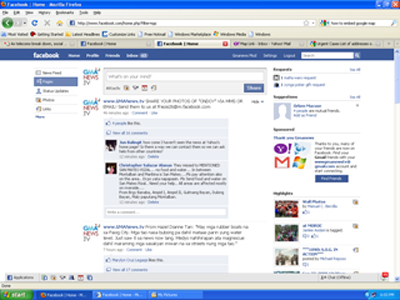Though the sun didn’t come out on Saturday morning, Jen (not her real name) happily said goodbye to her only son, 12, who was excited to represent his class in a chess tournament. Little did Jen know that she would soon regret letting him out of her sight. Network nightmare As Jen and her husband Ben (not his real name) left their home in Pasig and went to work in Makati, tropical storm “Ondoy" began its fierce assault. When Jen saw that the storm wasn’t going to let up, she immediately tried to get hold of the teachers who were her son’s chaperones for the day. Alas, cell phone networks had started to break down. “I felt so helpless," she disclosed. “I couldn’t get to my son."
View Urgent Cases List of addresses of flood-stranded people needing rescue in a larger map Still, Jen could do nothing but hope that her son was somehow alright. The weather had taken a turn for the worse and roads became impassable. Jen and her husband were stranded at their offices and had no choice but to spend the night in Makati. Unable to sleep, Jen kept trying to get in touch with her son’s teachers. She was unable to get through. Support groups Extremely frustrated, Jen turned to Facebook and started scanning GMANews.TV’s fan page for updates. There she saw many other people who were clamoring for updates about the areas that “Ondoy" had affected. Though she was still worried sick about her son, Jen found a little bit of comfort in the fact that she was not alone. Jen was only one of the many Filipinos who utilized the Web not only for the latest news updates about the storm, but also to share information and send SOS messages about missing loved ones. Selfless updates On the microblogging site Twitter, “Ondoy" and “NDCC" (National Disaster Coordinating Council) became top trending topics on Saturday, mostly due to Filipinos tweeting locations of people in need of help, and contact numbers of disaster relief agencies that they could ask for help. Celebrity Bubbles Paraiso, for example, tweeted to ask for help for a pregnant woman who was about to give birth while stranded in a village in Cainta, Rizal on Saturday night. The pregnant woman reportedly delivered the baby safely at home on Sunday morning, but remained stranded in the area. At another microblogging site, Plurk, Filipino users not only “plurked" emergency numbers but also suggested ways to channel donations to the disaster victims. “Let us reach out to the victims of typhoon ‘Ondoy.’ In this time of need, every charitable act will matter," said a Filipina with the username pearlychelle.

Many Filipinos are turning to social media to share information and send SOS messages about missing loved ones.
The social networking site Facebook was also flooded with calls for help and wall posts on information about relief centers and hotline numbers.
GMANews.TV’s Bagyong “Ondoy" Facebook discussion thread became an interactive bulletin board where Filipinos from around the world posted queries about loved ones, contact numbers, addresses, and offers of help. Some neighbors even finally got to know each other as they sent out their social media SOS. Bloggers and other citizen journalists did the same, foregoing sleep just so they could publish updates and advisories, as well as upload interactive spreadsheets and maps to help rescue teams, government agencies, non-government organizations, and concerned individuals conduct rescue operations.
Virtual lifesavers A tech-savvy Filipino who goes by username KaninLamig (Cold Rice) created an interactive Google map using data from GMANews.TV’s Facebook page, among others, that pinpointed dozens of locations where people were known to be waiting to be rescued. A number of volunteers soon offered to help update the map. Facebook user Capsaicin Angel found the interactive map useful for helping her company’s management “make sure employees arrived at their respective homes safely," she said. For his part,
Blogger Manuel L. Quezon III kept his site well updated, providing links to other helpful sites, including KaninLamig’s Google map. “Fellow bloggers may want to help on collating specific types of information they encounter online: appeals for rescue, traffic/flood updates, places to send relief goods, power failures, etc. This allows relief workers and media to focus on who needs help," Quezon wrote in a blog post. A site entirely dedicated to “Ondoy" was built on the blogging platform Tumblr. Photos of many heavily flooded areas were posted on the site. Videos of flooded areas were also uploaded on YouTube. Through clicks, posts, tweets and blogs, Filipinos found alternative means to extend simple acts of help to those in need of them. “It’s the
bayanihan spirit that's keeping us afloat—not this administration," said Twitter user ninaterol.
Family reunion By Sunday noon, Jen was all set to wade into the flood with her husband Ben in search of their son when they finally got news via Facebook. An acquaintance of hers, who happened to read her updates, used her own network of friends to track down the group who had gone to the competition with her son. Jen breathed a sigh of relief when a message sent to her Facebook inbox revealed that her son and his companions were safe in a building near the school where he was supposed to compete. A tearful family reunion occurred soon after, made possible by the Good Samaritans of the World Wide Web. -
GMANews.TV 



